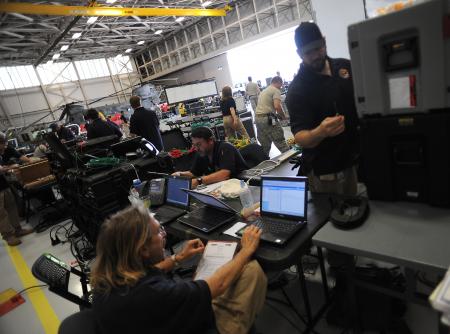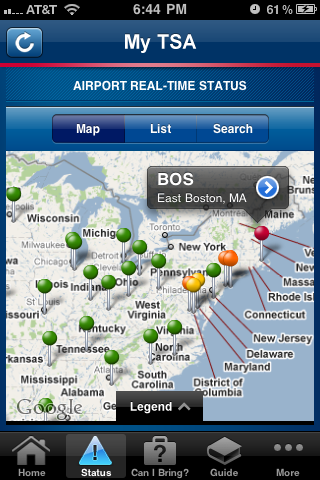In This Issue: November 25, 2013
|

Wishing you and your family a wonderful Thanksgiving! This Thanksgiving we are grateful for the selfless, diligent people who work to protect our nation every day. As we settle in to enjoy the bounty of America this holiday we remember those who have paid the ultimate price to offer each of us the peace, security and safety we enjoy. |
|
THE NATIONAL SUPPLY CHAIN: REDUCING THE VULNERABILITIES
|


NEW SPEAKERS ADDED!
Join the Government Technology & Services Coalition (GTSC) for a program featuring an overview of acquisition, technology and innovation in the intelligence community to both assure we have the most advanced protections in place to mitigate our vulnerabilities, and the most recent tools and information on how to protect intellectual property, prevent insider threats and understand supply chain considerations in the government contracting environment. Keynote Frank Montoya, Jr., National Counterintelligence Executive, Office of the Director of National Intelligence will keynote with a preview of the 2013 Economic Espionage Report (EER).
Agenda At A Glance
12:00 PM Welcome & Introductions
12:30 PM Keynote: Trends in Economic Espionage: An Overview by the National Counterintelligence Executive
1:30 PM CERT & Insider Threat
2:00 PM Best Practices on Insider Threat & Supply Chain Security
3:00 PM Cyber Threats & Vulnerabilities to Small & Mid-Sized Companies
3:30 PM Acquisition, Technology & Innovation
4:15 PM What Can Business Do?
KEYNOTE ADDRESS:
The Honorable Frank Montoya, Jr.
Counterintelligence Executive
ONCIX
SPEAKERS INCLUDE:
Dr. David A. Honey
Director for Science & Technology
Assistant Deputy Director of National Intelligence for Science & Technology
ODNI
|
Joan McCarroll
Director
Systems Engineering and Integration
Center of Excellence
TASC
|
Kathy Mills
Corporate Security Officer
& Security Director
CENTRA Technology, Inc.
|
Randy Trzeciak
Senior Member of the Technical Staff
Software Engineering Institure
CERT
Carnegie Mellon University
|
Bill Wright
Director, Cyber Security Partnerships
Symantec
|
William Stephens
Director
Defense Security Services
U.S. Department of Defense
|
Mitchell Kanefsky
Supervisory Special Agent
Federal Bureau of Investigation
|
Elena Kim-Mitchell
Director, Private Sector Partnerships
Office of the Director for National Intelligence
|
|
| PERSONNEL SECURITY CLEARANCES: REFORMS STILL NEEDED |
  In July 2012, GAO reported that the Director of National Intelligence (DNI), as Security Executive Agent, had not provided executive branch agencies clearly defined policy and procedures to consistently determine if a position requires a personnel security clearance. Absent this guidance, agencies are using an Office of Personnel Management (OPM) position designation tool to determine the sensitivity and risk levels of civilian positions which, in turn, inform the type of investigation needed. OPM audits, however, found inconsistency in these position designations, and some agencies described problems implementing OPM's tool. This testimony addresses policies and procedures executive branch agencies use when (1) first determining whether federal civilian positions require a security clearance and (2) periodically reviewing and revising or validating existing federal civilian position security clearance requirements. PERSONNEL SECURITY CLEARANCES: Actions Needed to Help Ensure Correct Designations of National Security Positions GAO-14-139T, Nov 20, 2013 READ THE REPORT. |
| DSS UPDATES INFORMATION ASSURANCE REQUIREMENTS FOR CLEARED CONTRACTORS |
  The Defense Security Service (DSS), Office of the Designated Approving Authority (ODAA), has updated its Manual for Certification of Classified Systems Under the NISPOM to provide guidance and clarification to enhance the information systems security program and to improve consistency and information for industry partners to implement program requirements. The process manual, targeted to cleared contractors under DSS cognizance, is designed to provide a full spectrum of resources to newly appointed contractor Information Systems Security Managers (ISSM) and well-seasoned Information Systems Security Officers (ISSO) alike. The process manual explains process standards, management control standards, operation control standards, technical configuration standards, and (M)SSP standard templates. Adherence to the standards in this process manual, by NISP contractors, is highly recommended in order for DSS to expeditiously issue Interim Approvals to Operate (IATO) and Approvals to Operate (ATO). Find the Full Manual Here. |
| DOD'S BUDGET ESTIMATES MORE OPTIMISTIC THAN CBO |

 For fiscal year 2014, DoD requested appropriations totaling $607 billion. Of that amount, $527 billion was to fund the "base" programs that constitute the department's normal activitieoun For fiscal year 2014, DoD requested appropriations totaling $607 billion. Of that amount, $527 billion was to fund the "base" programs that constitute the department's normal activitieoun
s, such as the development and procurement of weapon systems and the day-to-day operations of the military and civilian workforce. The remaining $79 billion was requested to pay for what are termed overseas contingency operations (OCO)-the war in Afghanistan and other nonroutine military activities elsewhere. The FYDP describes DoD's plans for its normal activities and therefore generally corresponds to the base budget. DoD's 2014 plans are similar to its 2013 plans.
The costs to implement DoD's 2014 plans would increase over the next 15 years. Under the CBO projection, after adjusting for inflation, the annual cost of the plans would grow from $534 billion in 2014 to $559 billion in 2018 and $615 billion in 2028, for an average annual growth rate of 1.0 percent from 2014 to 2028 (see the figure below). The projected growth in the costs of DoD's plans over the next fifteen years can be attributed to two main factors:
- The rising costs of operation and support (O&S), which accounts for 67 percent of the cost to implement DoD's plans in 2014, resulting from significant increases in the costs of military health care, compensation of the department's military and civilian employees, and various operation and maintenance activities. After adjusting for inflation, O&S costs would rise by 1.2 percent a year between 2014 and 2028, CBO projects.
- The rising costs of replacing and modernizing weapon systems, which accounts for 31 percent of the cost to implement DoD's plans in 2014. CBO projects that, after adjusting for inflation, the costs of such activities would rise by 3.0 percent a year between 2014 and 2021, remain at about the 2021 level through 2025, and then decrease through 2028.
CBO's analysis yields three conclusions:
- Using DoD's estimates of costs and CBO's extension of those estimates, the department would need $527 billion in 2014 to execute its base budget. Costs would then edge down, to $524 billion by 2018 after adjusting for inflation, before rising again, to $575 billion in 2028. Between 2014 and 2028, costs would grow at an average annual rate of 0.6 percent after adjusting for inflation.
- DoD's estimate of the cumulative cost of its plans over the 2014-2018 period is 3.4 percent lower than the CBO projection, an average of $19 billion less per year after adjusting for inflation. The cumulative cost of DoD's plans through 2028 (using DoD's estimates and CBO's extension of the FYDP) is 5.6 percent lower than the CBO projection, an average of $33 billion less per year.
- DoD's estimate of the cost of its base budget in 2014 is $7 billion less than CBO's estimate for two reasons. First, CBO includes the cost of all active-duty personnel, whereas DoD proposes to shift the cost of some of those personnel (including not only their pay but also some other costs to support those personnel) to the OCO budget. Second, CBO assumes that the Congress will continue its history of rejecting many of DoD's proposals to shift some health care costs to the military beneficiaries receiving the care.
Read the full report:
Long-Term Implications of the 2014 Future Years Defense Program, Congressional Budget Office, November 2013
|
| MARITIME SECURITY: PROGRESS & CHALLENGES IN KEY DHS PROGRAMS TO SECURE MARITIME BORDERS |
 An attack on the maritime system could have dire consequences and affect the global economy. In addition, criminals could use small vessels to smuggle narcotics, aliens, and other contraband across U.S. maritime borders. Within DHS, the Coast Guard is responsible for many homeland security efforts in the maritime domain, including conducting port facility and commercial vessel inspections and coordinating maritime information-sharing efforts, among other things. In addition, CBP is responsible for screening incoming vessels' crews and cargo to facilitate the flow of legitimate trade and passengers. - Maintaining robust maritime domain awareness
- Assessing risks coming from foreign ports
- Conducting maritime surveillance, interdiction, and security operations
- Measuring performance. In securing maritime borders, DHS and its component agencies have faced challenges developing meaningful performance measures.
MARITIME SECURITY: Progress and Challenges in Key DHS Programs to Secure the Maritime Borders GAO-14-196T, Nov 19, 2013 |
| ACTIONS NEEDED TO IMPROVE DOD'S PLANNING FOR A COMPLEX CATASTROPHE |
  The United States continues to face an uncertain and complicated security environment, as major disasters and emergencies, such as the Boston Marathon bombings and Hurricane Sandy illustrate. DOD supports civil authorities' response to domestic incidents through an array of activities collectively termed civil support. GAO recommends that combatant commands (1) work through the defense coordinating officers to develop an interim set of specific DOD capabilities that could be provided to prepare for and respond to complex catastrophes, as FEMA completes its five-year regional planning cycle; and (2) develop, clearly define, communicate, and implement a construct for the command and control of federal military forces during multistate civil support incidents such as complex catastrophes. DOD concurred with both recommendations. The United States continues to face an uncertain and complicated security environment, as major disasters and emergencies, such as the Boston Marathon bombings and Hurricane Sandy illustrate. DOD supports civil authorities' response to domestic incidents through an array of activities collectively termed civil support. GAO recommends that combatant commands (1) work through the defense coordinating officers to develop an interim set of specific DOD capabilities that could be provided to prepare for and respond to complex catastrophes, as FEMA completes its five-year regional planning cycle; and (2) develop, clearly define, communicate, and implement a construct for the command and control of federal military forces during multistate civil support incidents such as complex catastrophes. DOD concurred with both recommendations. |
| PLEASE JOIN US FOR GTSC'S HOLIDAY AWARDS! |
  DECEMBER 10 | 5:30 - 9:00 PM | Arlington, VA DECEMBER 10 | 5:30 - 9:00 PM | Arlington, VA 
The Government Technology & Services Coalition invites you to celebrate its 2013 award winners at our Annual Holiday event December 10! We congratulate: Federal Small Business Champions of the Year |
John Morton
former Director
U.S. Immigration & Customs Enforcement
|
Jonathan Porter
Chief of Staff, Management & Administration
U.S. Immigration & Customs Enforcement
|
|
Small Business Member of the Year
President & CEO
PreSafe Technologies
Market Maven Award Mentor of the Year
|
Chad Sweet
Co-founder
The Chertoff Group
|
|
|
Strategic Partner of the Year Strategic Advisor of the Year
Brian Finch
Partner
Dickstein Shapiro
|
Bill Carroll
Managing Partner
StrikeForce Consulting
|
Join us to celebrate their accomplishments, contributions to the homeland and national security community and commitment to the mission of securing our nation.
Thank you to our early supporters:
GOLD SPONSORS
SUPPORTERS
IBM
OLD DOMINION STRATEGIES
STRATIVEST
>>Join us to support the Holiday Awards
|
|
| SUPPORT GTSC'S HOLIDAY AWARDS! |
 GTSC: APP OF THE MONTH GTSC: APP OF THE MONTH |
|

MY TSA MOBILE APP: Transportation Security Administration's mobile app for travelers
The My TSA mobile application (app) provides airline passengers with 24/7 access to the most frequently requested airport security information on any mobile device. The app includes information on what you can bring, airport info, TSA Pre-Check information, security wait times and much more. A must for frequent travelers!
Get it here.
|
| SMALL BUSINESS SATURDAY - 10% off GTSC MEMBERSHIP |
 Small Business Saturday is November 30th! Small Business Saturday is November 30th! 
To honor small businesses in our community, GTSC is offering 5% off memberships purchased during Thanksgiving week and 10% off those purchased on Saturday November 30th! Join your colleagues in the homeland and national security community to learn, network and grow through partnership and collaboration.
Contact us today to secure your membership!
For more information on all the activities and resources for small business Saturday, visit the SBA.
|
LEAPFROG SOLUTIONS LOOKING FOR VP OF STRATEGY & BUSINESS DEVELOPMENT 
 LeapFrog Solutions, a rapidly-growing strategic communications consulting firm in Northern Virginia, seeks an energetic, thought leader and strategic thinker with robust Federal government and Fortune 500 sales experience to serve as the Vice President of Strategy and Business Development. The ideal candidate for this executive position has a proven track record in Federal communications consulting. LeapFrog Solutions, a rapidly-growing strategic communications consulting firm in Northern Virginia, seeks an energetic, thought leader and strategic thinker with robust Federal government and Fortune 500 sales experience to serve as the Vice President of Strategy and Business Development. The ideal candidate for this executive position has a proven track record in Federal communications consulting.
Reporting to the Chief Executive Officer (CEO), this position's primary focus is to expand LeapFrog Solutions presence on current contract vehicles in federal and local government. Areas of specialization include emergency management, law enforcement, health care, and recruitment branding. Additionally, expand our presence among Fortune 500 companies in the areas of energy and finance.
>>Read More
|
|
FINAL THOUGHT FOR YOUR WEEK:
"Cultivate the habit of being grateful for every good thing that comes to you, and to give thanks continuously. And because all things have contributed to your advancement, you should include all things in your gratitude."
|
 It's About the Mission. The Government Technology & Services Coalition (GTSC) is a nonprofit 501(c)(6), non-partisan association of innovative, agile small and midsized company CEOs that create, develop, and implement solutions for the Federal homeland and national security sector. These companies founded the Coalition to band together to work with their Federal partners to achieve their mission despite significant budget challenges by bringing the innovation, creativity and exceptionalism of successful small businesses to the homeland and national security mission.
Our vision is to provide an ethical, effective platform for information exchange between the public and private sector on homeland and national security ideas, technologies and innovations.
Our mission is to two-fold: first, to provide exceptional advocacy, capacity building, partnership opportunities and marketing in the Federal security space for small and mid-sized companies. Second, to support and assist our government partners achieve their critical missions with the highest integrity; best and most innovative technologies; and results-based, quality products and services to prevent, protect against, mitigate, respond to and recover from any terrorist attack or natural disaster.
|
|
Connect with GTSC to get more news, articles & information!    
|
|
|
|
|